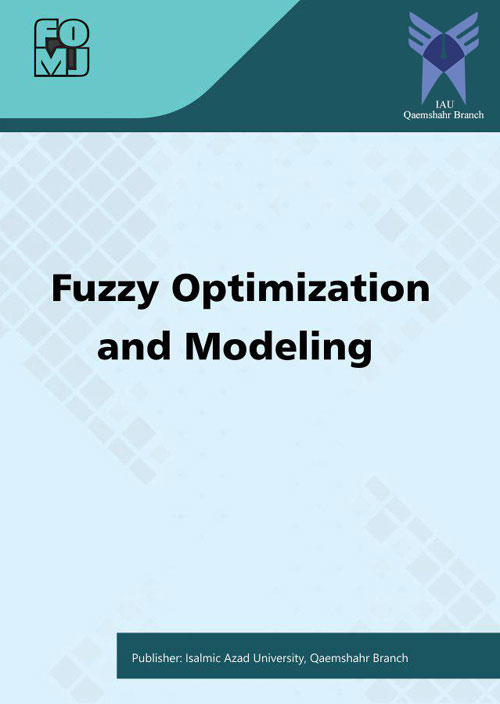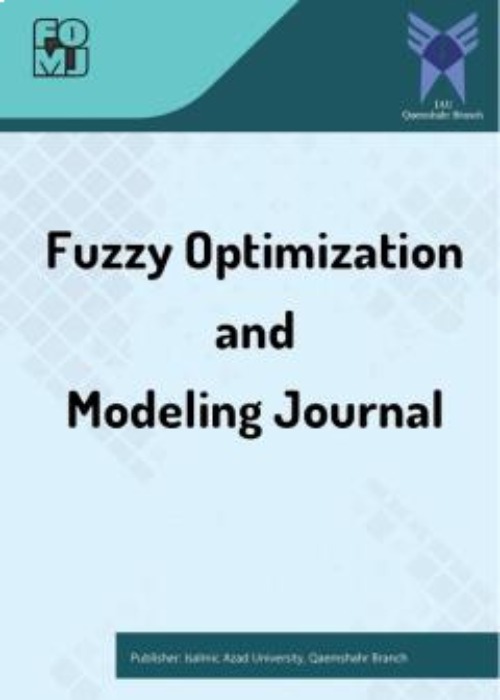فهرست مطالب

Fuzzy Optimzation and Modeling
Volume:2 Issue: 2, Spring 2021
- تاریخ انتشار: 1400/07/19
- تعداد عناوین: 6
-
Pages 1-11
Linear Programming as a practical technique for solving optimization problems with linear objective functions and linear constraint plays an essential role in mathematical programming. Most of the real-world problems are included in inconsistent and astute uncertainty. That's why the optimal solution can't be found easily. The Neutrosophic theory, as an extension of fuzzy set theory, is a powerful instrument to handle inconsistent, indeterminate, and incomplete information. This paper presents an applied approach for solving Interval Neutrosophic Integer Programming problems. By using the proposed approach, we can handle both incomplete and indeterminate data. In this respect, using a ranking function, we present a technique to convert the Interval Neutrosophic Integer Programming problem into a crisp model and then solve it by standard methods.
Keywords: Neutrosophic, linear programming, Integer programming, Interval neutrosophic number -
Pages 12-21In this paper, the fuzzy chance-constrained data envelopment analysis (FCCDEA) approach is presented for stock evaluation and portfolio selection under data ambiguity. To propose FCCDEA method, data envelopment analysis (DEA), possibilistic programming (PP), and chance-constrained programming (CCP) approaches are applied. It should be noted that FCCDEA models can be used by decision makers (DMs) under optimistic and pessimistic viewpoints. To show the applicability of the proposed fuzzy chance-constrained DEA approach, FCCDEA models based on possibility and necessity measures are implemented in a real-life case study from Tehran stock market. The results show the efficacy of the proposed FCCDEA approach for stock assessment in the presence of fuzzy data.Keywords: Fuzzy DEA, Possibility theory, Stock market, Data Ambiguity
-
Pages 22-33
Choosing the appropriate strategy is the most vital decision for an organization. The real-world situation, comprising increasing criteria and alternatives; the criteria interdependency; environmental changes affecting the structure of the organization; the vagueness of the verbal judgments; and Increasing uncertainty about possible futures, forces the decision-makers to consider these two important elements, complexity and uncertainty, in their decision-making approach. While all of the most widely known approaches – the classic, scenario, MCDM, and robustness analysis approaches – have some weaknesses related to either complexity or uncertainty, the approach purposed in this study can overcome them, combining the matrix approach to the robustness analysis (MARA) with the fuzzy ANP method. This approach deals with the environmental uncertainty by reviewing the performance of the strategies among the alternative futures, the uncertainty related to the preference model of the human decision-maker (uncertain judgements) by using fuzzy set theory, specifically Chang’s extent analysis method, considers desired number of scenarios, criteria and options, and collects experts' judgments in an appropriate time, emphasizing interdependences among criteria. The proposed approach is applied to a real-world problem in the automotive industry of Iran and the results are compared with the previous studies.
Keywords: decision making, Strategy Selection, Automotive Industry, Uncertainty, Complexity -
Pages 34-40Triangular Fuzzy numbers (TFNs) are vast and common representation of fuzzy data in applied sciences. Multiplication is a very indispensable operation for fuzzy numbers. It is necessary to decompose fuzzy systems such as fully triangular fuzzy regression models where the unknown and unrestricted triangular fuzzy coefficients multiplied by known TFNs as data input. Tens of research works and application of triangular fuzzy regression have dealt with degenerated existing multiplication expressions. This paper highlighted the drawbacks of such expressions and propounded a simple method (named as QKB method). The method is a straightforward method where there is no exaggeration for multiplying two or more TFNs. It respects the trinity-order condition of a TFN where the number without it cannot be considered as a TFN. Besides, it is suitable for known and unknown multiplied TFNs with conserving homogeneity principle such that the resultant of two symmetric TFNs has to be symmetric either, to prove that a proposed new membership function for a TFN (named quantified membership function) has been used. Illustrative examples have shown the soundness of the proposed method and the drawbacks of existing expressions. Furthermore, its expression of multiplication is more efficient than other expression on the needs of computation.Keywords: Triangular fuzzy numbers (TFNs), Trinity order condition, homogeneity principle, quantified membership function
-
Pages 41-45In 1972, within a study of the structure-dependency of total π-electron energy (E), it was shown that E depends on the sum of squares of the vertex degrees of the molecular graph (later named first Zagreb index), and thus provides a measure of the branching of the carbon-atom skeleton. Topological indices are found to be very useful in chemistry, biochemistry and nanotechnology in isomer discrimination, structure–property relationship, structure-activity relationship and pharmaceutical drug design. In chemical graph theory, a topological index is a number related to a graph which is structurally invariant. One of the oldest most popular and extremely studied topological indices are well–known Zagreb indices. In a (molecular) graph G, the Zagreb topological index is equal to the sum of squares of the degrees of vertices of G and the Zagreb coindex is defined as the sum of a graph’s vertex degrees which is not adjacent. In this paper, we obtain the Zagreb coindex of four operations on graphs.Keywords: Graph, Zagreb–index, F–sum, Zagreb-coindex
-
Pages 46-57Data envelopment analysis (DEA) is a mathematical technique based on linear programming applied to evaluate the efficiency of decision-making units dealing with multiple inputs and outputs. In classical DEA models, it is assumed that input and output data are accurate though real-world applications require considering inaccurate and ambiguous data. Moreover, linguistic forms may be intuitionistic in nature rather than fuzzy. We propose a novel approach to solve DEA models characterized by intuitionistic fuzzy data. The model is transformed into a linear programming problem with an intuitionistic fuzzy objective function, and an alphabetical technique is applied to solve it. The proposed approach is easy to implement, involving a lower number of calculations than more computationally demanding techniques introduced in the literature. It also provides a set of ranking results that are significantly correlated with those derived from the implementation of more complex techniques. Its applicability would allow to extend the analysis of intricate evaluation scenarios common to the standard DEA literature into intuitionistic fuzzy environments.Keywords: Data envelopment analysis, Intuitionistic Fuzzy Number, Intuitionistic Fuzzy Performance, Accuracy Function


